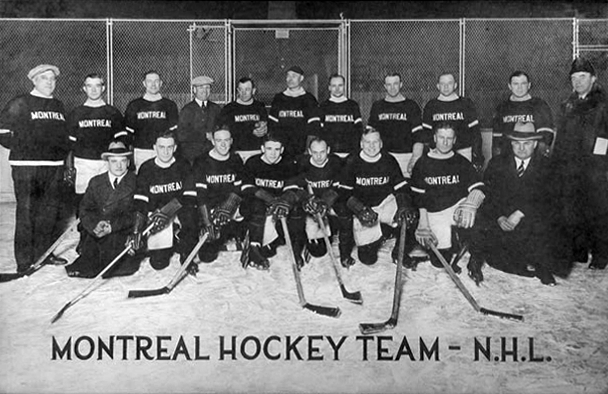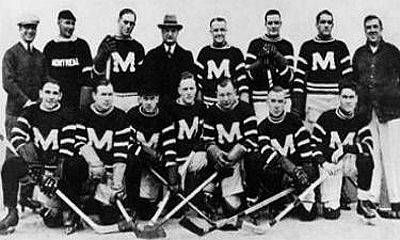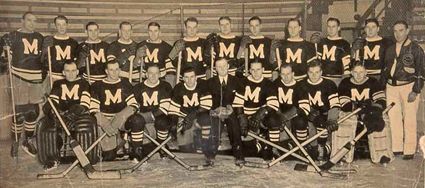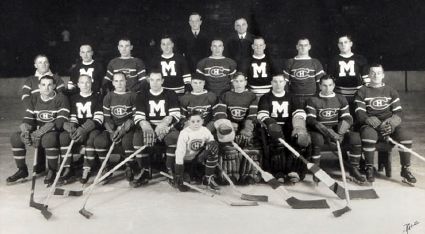Friday, December 10, 2010
1931-32 Montreal Maroons Hooley Smith Jersey
In 1923-24 the NHL consisted of just four member clubs, the Hamilton Tigers, Montreal Canadiens, Ottawa Senators and Toronto St. Patricks. The league expanded by two when the Boston Bruins, the first club based in the United States, and the Montreal Maroons were admitted to the league for the 1924-25 season, the NHL's eighth in their history.
The Maroons were based out of the brand new Montreal Forum, which was built specifically for the Maroons, only to have the Canadiens take the honors of playing the first game in the new arena when their home, the Mount Royal Arena, which did not have the capability to produce artificial ice, was unable to host their game against the St. Patricks due to poor ice conditions.
The Maroons first game was played on December 1, 1924, a 2-1 loss to their fellow expansion brothers, the Bruins. After two more games, another loss followed by the first win in club history, 3-1 over Ottawa, the Maroons faced off against the Canadiens, who just happened to be the defending Stanley Cup champions, for the first time ever on this date in 1924.
The established Canadiens were led by three men that season, Bill Boucher (31 points), second year pro Howie Morenz (34 points) and team scoring leader Aurel Joliat, who led the Canadiens with 29 goals and 40 points. Those three men dominated team scoring that season with a remarkable 79.5% of their total, 105 out of the team's 132 points.
In their game against the Maroons, Joliat scored four of the Canadians five goals, while Georges Vezina got his 9th career shutout in their 5-0 victory.
The Maroons would gain a tie with the Canadiens 17 days later, a 1-1 affair with overtime did not settle. January 14th saw them battle to another 1-1 overtime draw. The remainder of their meetings that season went the way of the Canadiens when they repeated their 5-0 win again on January 31st, shut the Maroons out for the third time in a 1-0 win on February 18th and took their third in a row 3-1 on March 7th.
The 1925-25 Montreal Maroons
After finishing fifth in their first season, ahead of only Boston, the Maroons fielded a much stronger club during their second season of 1925-26, climbing up to second place overall in the now seven team NHL. Their first ever victory over the Canadiens did not take long to arrive, as they downed the Canadiens 3-2 in their first meeting of the new season. The Maroons dominated the inter-city rivalry that season, taking five of six from The Habs, including a pair of shutouts.
The improved play of the Maroons heightened the rivalry between the two clubs, which was already fueled by the fact the Maroons were the club of choice for Montreal's English speaking population, while Les Canadiens were the darlings of Montreal's francophone supporters.
Following the regular season, the Maroons defeated the third place Pittsburgh Pirates 6 goals to 4 in their playoff series to advance to the league championship, where the Maroons upset the established Senators in a closely fought pair of games. The first contest in the two-game, total-goals series was a 1-1 draw, setting up a winner-take-all second game, which went the Maroons way 1-0.
With the NHL championship in hand, the Maroons advanced to the Stanley Cup Finals versus the Victoria Cougars. Nels Stewart led the Maroons with six goals in four games as the Maroons shut out the Cougars by identical 3-0 scores in the first two games of the best-of-five series. The Cougars took a narrow 3-2 win to stay alive, only to have the Maroons close out the series with another shutout by goaltender Clint Benedict, this one a 2-0 victory to claim the prestigious Stanley Cup in only their second season.
The 1925-26 Stanley Cup champion Montreal Maroons - note Benedict in the back wearing his trademark ballcap and one of the previous season's jerseys
The Canadiens would move into the much more modern Forum the following season and would share the arena with the Maroons until 1938. The two clubs would also meet in the playoffs for the only that season when they met in the quarterfinals. They tied 1-1 in Game 1 of the two-game, total-goals series. The second game saw regulation end scoreless, and the Canadiens advanced with an overtime goal to take the series 2 goals to 1 and add another chapter in the growing rivalry of the two clubs who shared not only a city, but now an arena as well, even though they divided their fanbase along linguistic lines.
The Maroons would play for 14 seasons and qualify for the playoffs in ten of those seasons. Following their Stanley Cup in 1926 it would be another nine seasons before they would claim their second and final one in 1935. During the Maroons 14 seasons in the NHL, both the Maroons and Canadiens each won a pair of Stanley Cups, with the Canadiens coming back-to-back in 1930 and 1931.
The 1934-35 Stanley Cup champion Montreal Maroons
The Canadiens would not only win the all-time series between the two clubs 40-35-17, but add insult to injury by taking over as sole occupants of the arena originally built for the Maroons when the Maroons folded due to a lack of support during the Great Depression of the 1930's, which hit Canada particularly hard.
The one time the two clubs would come together would be in the Maroons final season, on November 2, 1937 when members of both Montreal teams paired up to take on a team made of All-Stars from the other six NHL clubs in a benefit game for the benefit of Morenz's family following his premature death in March of that year.
The Maroons and Canadiens team up for the Howie Morenz benefit game
Today's featured jersey is a 1931-32 Montreal Maroons Hooley Smith jersey. While Smith was a member of the Senators when the Maroons and Canadiens played their first game against each other, he was sold to the Maroons in time for the 1927-28 season and played for the club until the 1935-36 season, nine in all. He was named team captain in 1932 and remained so until he left the club in 1936. While with the Maroons Smith scored 130 goals and 151 assists for 281 points, making him the Maroons all-time franchise scoring leader, 14 points more than Jimmy Ward in 108 less games.
Smith won a Stanley Cup with the Maroons in 1936 to go with the one he won with Ottawa in 1927. Additionally, Smith also won a gold medal at the 1924 Olympics while playing for Canada.
With the Maroons decline underway, Smith was sold to the Bruins, who later sold him to the New York Americans. He would play 17 NHL seasons in all, scoring exactly 200 goals on his way tot totaling 425 points. He was elected to the Hockey Hall of Fame in 1972.
The Maroons jerseys underwent several changes in their 14 years. Their first jerseys had the the name "Montreal" across the chest in simple block letters. They replaced that with the large "M" crest for year two, in which they won the Stanley Cup. Those jerseys featured four white stripes down the arms and two around the waist.
In 1929 styles had changed and their jerseys now had nine thinner stripes running down the arms and the waist stripes were increased to three. After two seasons they switched to the "Northwestern" stripe pattern (a thick center stripe flanked by two thinner stripes) for the rest of their history with the only change being to the font used for the "M" in 1935. During that era teams almost exclusively wore one style of jersey, so the Maroons never wore a white version of their famous maroon sweaters.
Today's video is a look at the evolution of hockey in Canada, which features the Maroons Clint Benedict, the first man to wear a goalie mask in an NHL game.
Labels:
Montreal Canadiens,
Montreal Maroons,
Smith Hooley
Subscribe to:
Post Comments (Atom)
















No comments:
Post a Comment
We welcome and encourage genuine comments and corrections from our readers. Please no spam. It will not be approved and never seen.